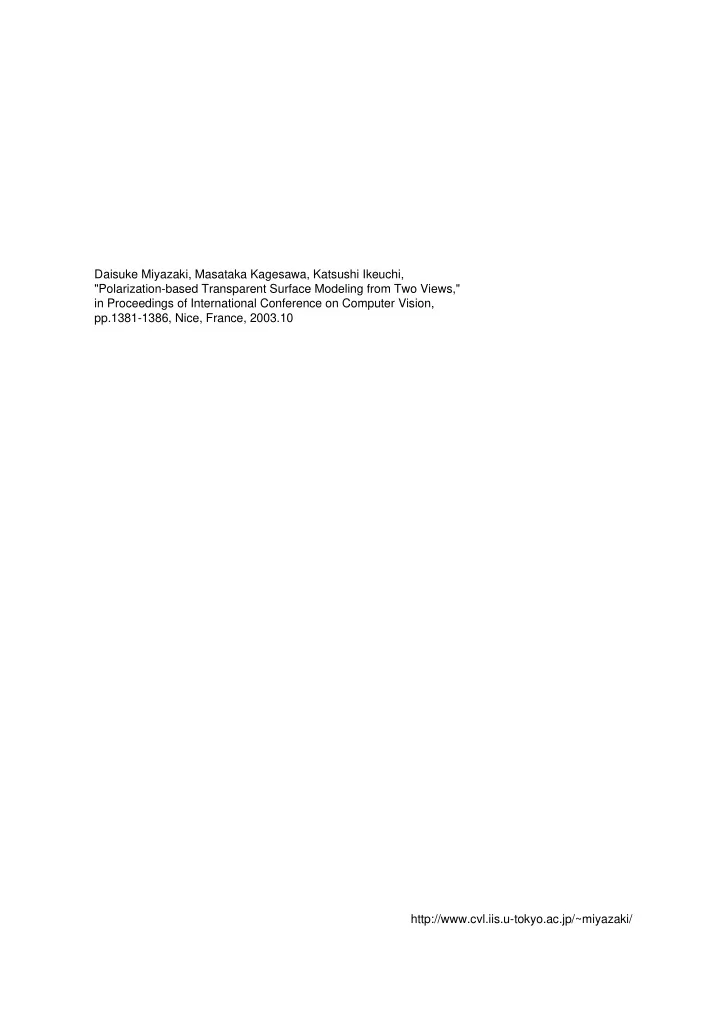

Daisuke Miyazaki, Masataka Kagesawa, Katsushi Ikeuchi, "Polarization-based Transparent Surface Modeling from Two Views," in Proceedings of International Conference on Computer Vision, pp.1381-1386, Nice, France, 2003.10 http://www.cvl.iis.u-tokyo.ac.jp/~miyazaki/
Polarization- -based Transparent Surface Modeling from Two Views based Transparent Surface Modeling from Two Views Polarization Daisuke Miyazaki, Masataka Kagesawa, Katsushi Ikeuchi ICCV proceeding pp.1381-1386 Obtained Surface Shape Real Image � Abstract We developed a method to obtain 3D shape of object surface from the polarization state of reflected light on transparent objects observed from two views. � Method 1. Measure the polarization state of the light reflected on the surface. 2. Rotate the object in a small angle, and again measure the polarization data. 3. Apply a region segmentation method to both two DOP(degree of polarization) data. 4. Detect a point which represent the same surface point in each region in each DOP data. 5. Determine the surface normal by comparing two DOPs taken before/after rotation at corresponding points. 6. Obtain the surface shape of transparent objects from the distribution of surface normal. Transparent Surface Modeling Methods Number of Number of input images for Advantage in our Approach Disadvantage vs viewpoints each viewpoints method Multiple images with different Murase 1990 Optical flow 1 viewpoint Only water wave Solid objects ⇔ time Need calibration Pattern light Multiple images with different No calibration Hata et al. 1996 1 viewpoint between camera and ⇔ projecting projected pattern light needed projector Shape from Multiple images with different Ohara et al. 2003 1 viewpoint Only edged object Smooth objects ⇔ focus focus Ben-Ezra & Nayar Shape from Multiple Only parameterized Many types of 1 image each ⇔ 2003 motion viewpoint object objects Previous method Shape from 1 polarization 1 viewpoint Ambiguity problem Solved the problem ⇔ polarization image [Saito et al. 1999] 3 or more Previous method Shape from 2 polarization images for 1 1 viewpoint Need infrared camera Only visible camera ⇔ polarization images polarization [Miyazaki et al. 2002] image Our method Shape from 1 polarization 2 viewpoint polarization image each [Miyazaki et al. 2003] http://www.cvl.iis.u-tokyo.ac.jp/
Daisuke Miyazaki, Masataka Kagesawa, Katsushi Ikeuchi, “Polarization-based Transparent Surface Modeling from Two Views” Outline DOP Search Rotate Region (Degree Of corresponding the object segmentation Polarization) points images Target 3D model object Reflection and Polarization DOP (Degree Of Polarization) Camera 2 2 2 2 2 2 2 2 I I 2 sin 2 cos n 2 sin 2 2 sin θ ( n − sin θ − n sin θ )( 2 n − sin θ − n sin θ ) − θ θ − θ ′ ρ = max min = ρ = I + I n 2 − sin 2 θ − n 2 sin 2 θ + 2 sin 4 θ 2 2 2 2 2 2 4 2 Surface normal n − sin θ ( n − sin θ − n sin θ + 2 sin θ ) max min Partially ( ) ( ) ( ) ′ polarized ρ θ + ∆ θ − ρ θ = ρ θ ∆ θ light Unpolarized Linear DOP DOP light Polarizer Derivative Rotation Reflection after before of DOP angle Light Incident angle rotation rotation source angle 1 DOP ρ Degree Of Object Polarization Rotating the Object 0 + Camera Derivative of 0 DOP ρ í Rotate ñ Object 90 ° Brewster angle Reflection angle Gaussian Mapping and Regions N N N N N F B B B B F DOP image E E E E Regions or B-E region B-B region B-N region Gaussian spheres Observation B: Brewster curve N: North pole E: Equator F: Folding curve
Computer Vision Laboratory, Institute of Industrial Science, The University of Tokyo, Japan Folding Curve Corresponding Point � Theorem: Folding curve is parabolic curve � Parabolic curve = a curve where Gaussian curvature is 0 ⇒ Folding curve = geometrical invariant North pole North pole Corresponding North pole point F F B B B-B region B-B region Folding curve B-B region Brewster curve Rotation circle Rotation circle E E Rotation Rotation Equator direction direction Rotate the Gaussian sphere Gaussian sphere object Gaussian sphere North side Experimental Setup or South side Light Camera North pole North pole Light Corresponding Polarizer point Rotation circle Light B B B-B region B-B region F F Spherical Rotation circle diffuser E E Rotation Rotation Object direction direction Rotate the Gaussian sphere Gaussian sphere object Result for Bell-shaped Transparent Object Diameter(width): 24mm Height error: 0.4mm Solid Line: Ground Truth Real Image Obtained Surface Shape Rendered Image Dotted Line: Obtained Shape Result for Another Object Future Work � Improvement of the precision � by dealing with inter-reflections � by using multiple data taken under different illuminations � by using multiple data taken from different views � Estimation of � the shape of backward surface � the refractive index � the extinction coefficient (=color of translucent objects) � Real-time system � Applications to � entertainments and VR � modeling cultural assets � industrial robots for productions such as transparent cellular phones, PCs, toys, etc. Real Image Obtained Surface Shape � classifying glass bottles for recycling
Recommend
More recommend